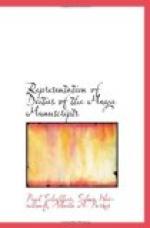The hieroglyph of this deity is thus explained; it is the head of the god merged into the conventionalized form of the ear of maize surrounded by leaves. When we remember that the Maya nations practised the custom of artificially deforming the skull, as is seen in particular on the reliefs at Palenque, we may also regard the heads of these deities as representations of such artificially flattened skulls.
God E occurs frequently as the god of husbandry, especially in the Madrid manuscript, which devotes much attention to agriculture. He seems to be a counterpart of the Mexican maize-god Centeotl. The passages in the Madrid manuscript (Tro. 29a and Cort. 39a, 40a) are very remarkable, where the deity E is represented in the position of a woman in labor with numerals on the abdomen; perhaps the underlying idea is that of fruitfulness.
In the Codex Cort., p. 40, this grain-deity is pictured with a tall and slender vessel before him, which he holds in his hands. It is possible that this is meant to suggest a grain receptacle; to be sure, in the same place, other figures of gods likewise have such vessels in their hands. At any rate, it is interesting to note that in the passage already mentioned (Dr. 50a) god E also holds a similar tall and slender vessel in his hands.
According to all appearances the scene pictured in Dr. 50a has reference to the conflict of the grain-god with a death-deity. The latter, the figure sitting on the right, is characterized by a skull as a head ornament (see Fig. 6) and seems to address threats or commands to god E, who stands before him in the attitude of a terrified and cowed individual.
Furthermore god E has nothing to do with the powers of the underworld; he is a god of life, of prosperity and fruitfulness; symbols of death are never found in connection with him. Brinton calls this god Ghanan, equivalent to Kan; it is possible, too, that he is identical with a deity Yum Kaax who has been handed down to us and whose name means “Lord of the harvest fields”.
According to Foerstemann the day dedicated to this god is Kan.
F. The God of War and of Human Sacrifices.
[Illustration: Figs. 28-34]
This is a deity closely related to the death-god A, resembling the Aztec Xipe, and may, I think, without hesitation be regarded simply as the god of human sacrifice, perhaps, even more generally, as the god of death by violence. His hieroglyph is Figs. 28-30; it contains the number 11. A variant of this occurs on Dr. 7b, where instead of the 11 there is the following sign: [Hieroglyph]




